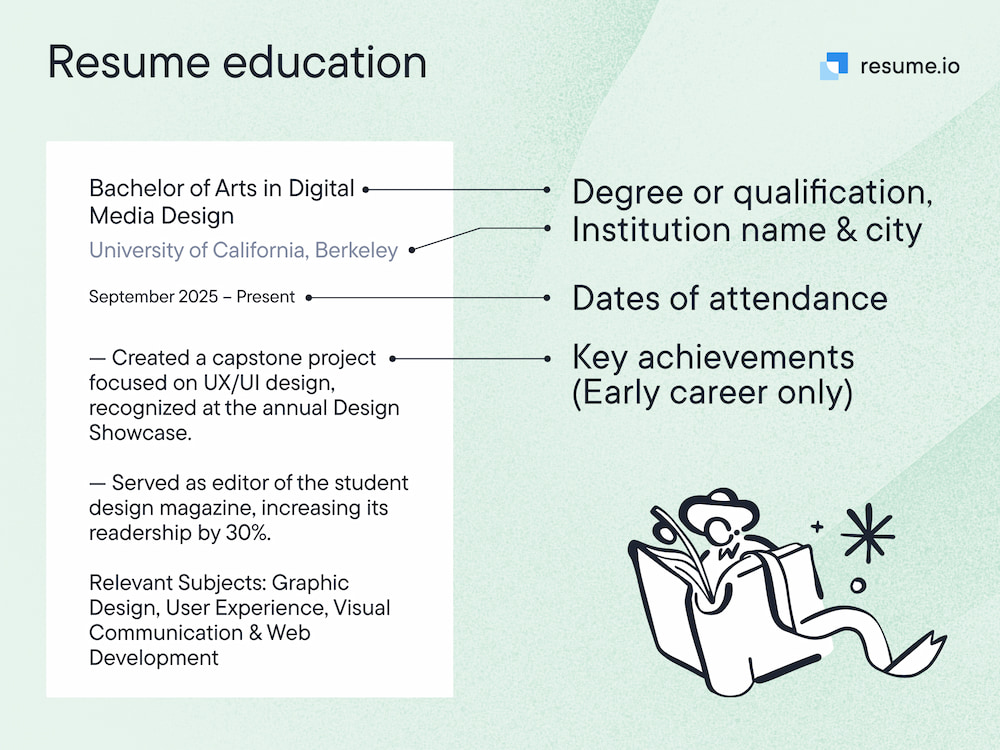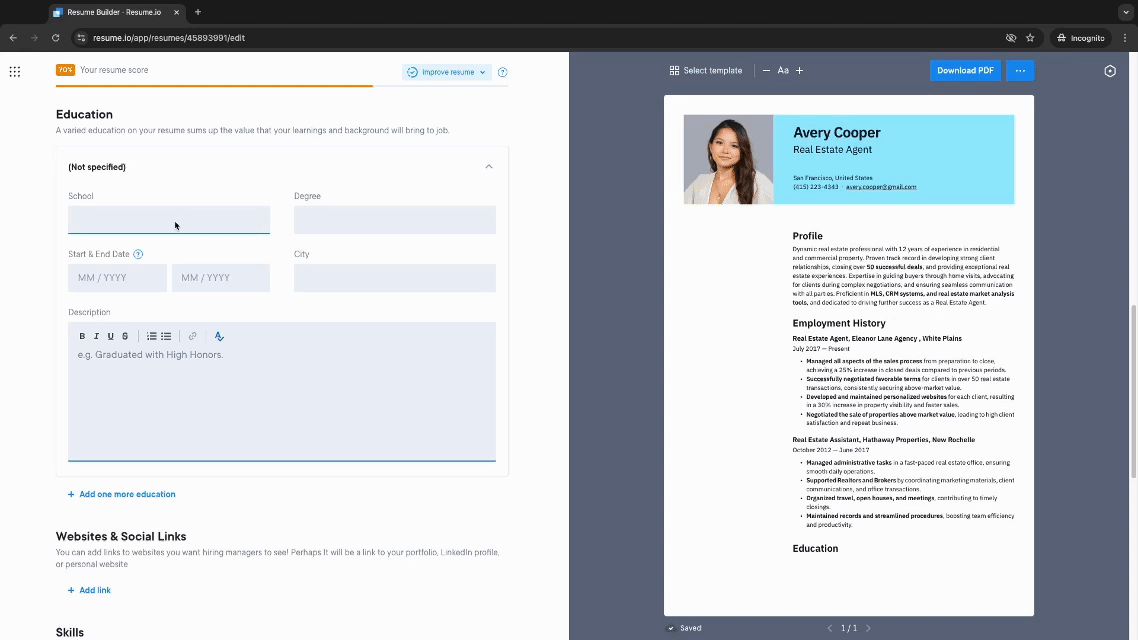A strong education could catapult you toward your dream job. To showcase your studies to recruiters, learn how to list a degree on your resume. Fortunately, there’s a straightforward formula you can use time and time again. Within this guide, we will cover the following:
- Why you should list a degree, or degrees, on your resume.
- General formatting advice when listing your degree or degrees.
- How to write an associate’s, bachelor’s, or master’s degree on your resume.
- Additional expert tips on how to format and write your education section.
Why should you list a degree on your resume?
It’s important to list your degree on your resume. Let’s face it, you don’t want those years of studying to go to waste. It takes an average of four to six years to earn a bachelor’s degree. Add that to your blood, sweat, and cash, and it’s quite a hefty investment.
When you’re applying for a job, a degree is a notable achievement. Whether it applies to the role or otherwise, it may turn the hiring manager’s head. Having a solid educational foundation shows that you have what it takes to work hard and succeed. If you are up against candidates with only a high school diploma, it may give you the competitive edge.

Having a degree shows drive, determination, and skill. However, you may no longer need one to land certain skill-based roles. The last decade has seen a colossal shift. More employers than ever are now prioritizing skills over education alone.
According to Harvard Business Review, between 2017 and 2019 employers lowered degree requirements for 46% of middle-skill positions and 31% of high-skill positions. While some positions will always require a degree, the same isn’t true across industries. It’s worth checking out the job market when you’re considering a college education.
There’s a right and wrong way to list your degree on your resume. Before you start working on your application, learning how to format this achievement is a major bonus.
How to list a degree on your resume: General format

When listing a degree on your resume, it needs to be clear and simple. Recruiters’ time is precious. They should be able to scan your document and get the information they need.
Luckily, there’s a standard format you can use every time. You will need to include the following details:
- The University Name
- Start and End Dates
- Degree Type
- Major
- Minor (if you had one!)
Looking to bolster your resume? You can add some extra information about your degree. With that in mind, you may find that it’s useful to include:
- Honors
- Coursework Subjects
- GPA
- Extracurricular Activities
If you were a member of a society or club during college — and it applies to the role — you might want to mention it. For example, if you were President of the Anthropological Society and you’re applying to work at a museum, be sure to mention it on your resume.
Check out our example below:
University of Texas at Dallas, TX
Bachelor of Science in Business
Aug 2008 - May 2012
- Graduated with High Honors
- GPA 3.9
While you don’t have to list bullet points below your degree, it can be useful. Figure out how much space you have on your resume before you add in these extras.

How to list multiple degrees on your resume
Are you a serial student? If you happen to have more than one degree under your belt, you must highlight that on your resume. As a general rule, you should use a reverse chronological approach. That means that your most recent degree appears first.
Of course, rules are there to be broken. If one of your degrees is more relevant to the job role than the other, you can highlight it by listing it first. Note that is the only time that you can switch up the order of your degrees on your resume.
Needless to say, your degrees sit under the education section of your resume. When it comes to formatting, they need to go above each other in order. See our example here:
University of Texas at Dallas, TX
Master of Science in Business
Sept 2012 - Sept 2014
University of Texas at Dallas, TX
Bachelor of Science in Business
Aug 2008 - May 2012
Once again, you can bullet-point some additional details below. However, you don’t want your education to take up too much space on your resume. Consider whether you have enough room to add in your GPA, honors, subjects, or any extra information.

How to write an associate degree on your resume
An associate’s degree is the lowest level of higher education, taking around two years to complete. When you’re listing this certificate on your resume, you should use the term ‘Associate of’. For example, you might write ‘Associate of Arts’ or ‘Associate of Science’.
Most of the time, you should use the full name for this type of degree. However, if you have a load of information to squeeze onto your resume, there are abbreviations you can use. Most employers will understand the following:
- AB = Associate of Business
- ABA - Associate of Business Administration
- AA = Associate of Arts
- AS = Associate of Science
- AAS = Associate of Applied Science
Don’t get too jazzy with the formatting. You should use the same format we have already mentioned and slip the ‘Associate of’ line beneath the university name. See our example:
University of Texas at Dallas, TX
Associate of Arts in English Literature
Aug 2012 - Aug 2014
Avoid using columns when listing your education. More than 50% of U.S. businesses now use Applicant Tracking Systems (ATS) to vet candidates. Complicated resume designs may confuse the software, meaning your application ends up in the ‘junk’ pile.
How to write a bachelor’s degree on your resume
Next up, let’s talk about bachelor’s degrees. When listing this type of degree on your resume, you should use the words ‘Bachelor of’ plus your discipline. So, you might write that you have a ‘Bachelor of Science’ or a ‘Bachelor of Education’.
Do you need to save some space? If things are getting tight, you can use some common abbreviations. Here are the main ones that you need to know about:
- BS = Bachelor of Science
- BA = Bachelor of Arts
- BEd = Bachelor of Education
- BBA = Bachelor of Business Administration
- BLA = Bachelor of Liberal Arts
- BSW = Bachelor of Social Work
- BFA = Bachelor of Fine Arts
If possible, you should write out the full title of your degree. However, if you’re applying for a role in which the hiring manager will be familiar with the abbreviation, you can use it. For instance, if you are going for a job at a school, the employer will understand BEd.
Need some inspiration? Check out our example here:
University of Texas at Dallas, TX
Bachelor of Social Work
Aug 2008 - May 2012
How to write a master’s degree on your resume
So you got a master’s degree? Good for you! You might have guessed it already — you’re going to use the words ‘Master of’ along with the discipline. Some examples of this include ‘Master of Arts’ and ‘Master of Science’.
Once again, there are some abbreviations you can use if you need to. Here are some of the most common ones you need to familiarize yourself with:
- MS (or MSc) = Master of Science
- MA = Master of Arts
- MEd = Master of Education
- MBA = Master of Business Administration
- ME = Master of Engineering
- MIB = Master of International Business
- MFA = Master of Fine Arts
- MAT = Master of Arts in Teaching
- MH = Master of Humanities
Chances are, you will stack your master’s degree above any previous degrees on your resume. The format you need to use is the same as before. Here’s an example:
University of Texas at Dallas, TX
Master of Arts in English Language
Sept 2012 - Sept 2014
Decide whether you want to use periods in your abbreviations. For example, you can choose between writing ‘MAT’ and ‘M.A.T’ when listing your degree. Simply make sure that you take the same approach to all of the degrees you list. Consistency is key.
Key takeaways
- Degrees may give you the competitive edge when applying for jobs. However, more and more recruiters are now valuing skills more highly than education.
- Keep things simple when it comes to the format. A recruiter should be able to quickly and easily see your educational background.
- You will need to include the basic information: university name, start and end dates, degree type, major, and minor (if applicable).
- If you have additional space, you can add details beneath your degree listing. You can include your honors, GPA, and any extracurricular activities.
- Don’t overcomplicate the design or you might not get past the ATS. Make things easy for yourself by using our recruiter-tested resume templates.










